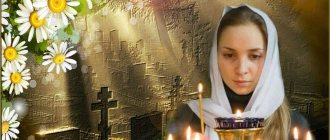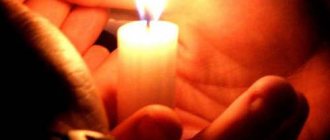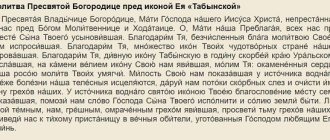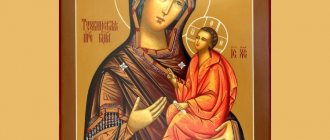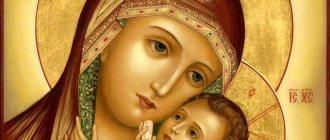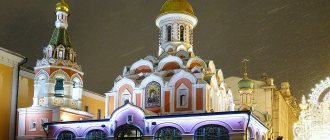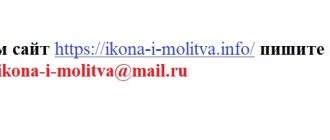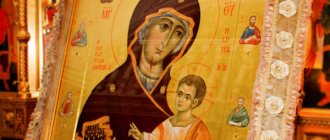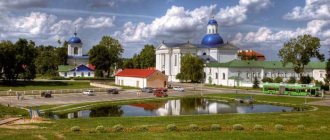History of the icon
The history of the Bogolyubskaya icon is connected with a real miracle that occurred in 1157, when Prince Andrei Dolgoruky went from Vyshgorod to Suzdal to establish the grand-ducal throne there. The prince was famous for his piety; with him were several very revered icons, including the miraculous icon of the Mother of God, which later received the name Vladimir.
On June 18 (July 1, new style), not far from the city of Vladimir, the cart on which the icon was being transported suddenly stood up, and no effort could be made to move it. When the prince retired to the camp tent to pray, the Mother of God herself appeared to him and ordered him to place Her miraculous icon, which he was carrying, in Vladimir, and at the place where the stop happened, to build a church and found a monastery. The prince ordered to paint an icon of the Mother of God, as he saw Her appearance.
Two years later, the Bogolyubskaya Icon of the Mother of God, as it came to be called, was brought with a solemn prayer into the temple, erected by order of the Mother of God. When the temple was burned during the Mongol invasion, only the icon “Our Lady of Bogolyubskaya” survived. Subsequently, she defended the monastery more than once, and after enemy destruction it was restored and acquired even greater glory.
The God-loving Icon of the Mother of God became most famous when a plague epidemic broke out in 1771, but thanks to the icon it did not affect either the monastery or the nearby village of Bogolyubovo. When the icon was transferred to Vladimir, the epidemic there miraculously stopped.
How does prayer before this image of the Virgin Mary help?
Icon of the Mother of God Bogolyubskaya
Before the Bogolyubskaya icon, prayers are traditionally offered for healing from illnesses, in case of any mental and physical sorrow. They pray to the Most Pure One for speedy intercession in difficult life situations. They especially pray for protection from natural disasters, epidemics, pacification of national strife, for the harvest, peace in the country, and for travelers. Remembering the miracles of healing revealed by the Bogolyubskaya icon, they ask for the recovery of sick children.
Description of the icon
The original Bogolyubskaya icon came to us in a catastrophic state: very poor preservation, numerous subsequent layers did not allow us to see its original appearance, and only thanks to restorers we have an idea of how colorful it was. The peculiarity of this icon is that, unlike Byzantine examples, the face of the Virgin Mary is more consistent with Slavic ideas about the ideal of beauty. This highlights the brighter color on Her cheeks and her bright blue rather than brown eyes.
On the Bogolyubskaya icon, the Mother of God is depicted according to the description of the prince himself: She stands in full height, Her face and hands, raised in prayer, are turned to Jesus, whose image is placed in the upper right corner. In the right hand of the Mother of God there is a scroll with a prayer, and above Her head there are marks with five icons that the prince carried with him.
According to its iconographic type, the Bogolyubskaya icon belongs to Agiosoritissa (Intercessor, Petitioner) and is considered a “votive” icon.
Often, lists from it were written “according to a vow,” and then the person who ordered the list could be depicted below, falling at the feet of the Mother of God. A list with the kneeling Prince Andrei Bogolyubsky is also widespread.
Sometimes on the lists of icons they depicted a whole group of saints and saints bowing before the Mother of God and offering prayers to Her, and at the top - Jesus Christ blessing His Mother, the Queen of Heaven (this is emphasized by the royal crown on Her head). In churches, similar images of the Mother of God Agiosoritissa usually serve in pairs with the image of Christ the Merciful.
Iconography
There are the following iconographic types of images of the Mother of God:
- Oranta - Mother of God holding a baby in her arms, with raised arms and palms facing outward;
- Eleusa - the Most Pure Virgin with a baby who presses her cheek to her mother;
- Hodegetria - The Virgin Mary sitting on a throne. In her arms she holds a baby with a scroll;
- Panahranta - The Virgin Mary seated on a throne with a baby in her arms. The Mother of God's hand is directed towards the baby;
- Agiosoritissa - The Most Pure Mother of God without a child in prayer.
The iconographic type of the Bogolyubskaya icon is Agiosoritissa. It symbolizes the prayer of the Mother of God for people. However, it also contains elements of other iconographic types - Hodegetria and Oranta.
Iconographic type of the Bogolyubskaya icon - Agiosoritissa
Prayer before the icon
O Most Pure Lady Theotokos, God-loving Mother, Hope of our salvation! Look mercifully at this people, coming with faith and love and worshiping Your most pure image: accept our singing of praise and pour out Your warm prayer for us sinners to the Lord, that, having despised all our sins, He will save and have mercy on us. O Precious Lady! Show us Your wonderful mercies: keep the church shepherds and all the Christ-loving army unharmed. We pray to You with tenderness, deliver us from all sorrow, guide us on the path of all virtues and goodness, save us from temptations, troubles and diseases, remove slander and strife from us, save us from lightning thunder, from the burning of fire, from famine, cowardice, flood and deadly ulcers: give us Your merciful help on the way to sea and land, so that we do not perish violently. O All-Merciful, God-loving Mother! With firm hope, we send to You our humble prayer: do not reject our tears and sighs, do not forget us all the days of our life, but always remain with us and through Your intercession and intercession with the Lord, give us joy, consolation, protection and help, may we endure We glorify and magnify Your most blessed and all-sung name. Amen.
( 6 ratings, average: 4.17 out of 5)
Where is the holy image located?
From the very moment of its discovery, the Bogolyubskaya icon was in the Church of the Nativity of the Virgin Mary, which was founded by Prince Andrei Bogolyubsky 10 miles from Vladimir - on the place where the Mother of God appeared to him. The Bogolyubsky Monastery was later built near this temple. The holy image of the Mother of God remained in it until the beginning of the 20th century.
After the monastery was closed, the icon was transported to Vladimir, where it remained in the Church of Joachim and Anna until the end of the Great Patriotic War. After the war, the location of the icon was determined to be the local history museum of the city of Vladimir. There it remained until 1992, after which it was moved to the Assumption Cathedral, where it remained for 17 years. After this, due to the poor condition of the icon, it was decided to transfer it to the Vladimir-Suzdal Museum for restoration. This miraculous image is still there today.
The original face of the Mother of God was not discovered immediately - only after restoration in 1970
The Virgin Mary of Bogolyubskaya is depicted in full height. In her hand, the Virgin Mary holds a scroll with the words of a prayer, and her face is turned to the Lord with a request to send a blessing.
Some versions of the icon also depict Prince Andrei Bogolyubsky humbly falling at the feet of the Heavenly Queen.
Bogolyubskaya icon of the Mother of God with the image of kneeling Andrei Bogolyubsky. One of the icon options
The image is written extremely skillfully. Judging by the style of writing, we can say that the authorship belongs to an icon painter of the Byzantine school.
However, the original painting has almost never reached us. Throughout history, Bogolyubskaya has been touched by more than one artist’s brush, so her true appearance was hidden under layers of reproduction.
Only by 1970 were Moscow restorers able to uncover and later partially restore fragments of the prototype.
Face of the Most Holy Theotokos Bogolyubskaya. View after restoration
How great the significance of the Bogolyubskaya Icon is for the Russian people can be judged by the number of copies from it. Some of them showed themselves to be miraculous.
One of the copies from the Bogolyubskaya Icon of the Mother of God
Revered miracle-working lists from icons
The list is a copy made from the original icon. Over the thousand years that have passed since the discovery of the Bogolyubskaya Icon, the Russian people have created dozens of copies of this image, which have perceived its miraculous power. Prayers were performed in front of these lists during epidemics, internal strife and during the invasion of external enemies.
The oldest list is the Moscow Icon of the Bogolyubskaya Mother of God. The list is famous for saving the residents of Moscow from an epidemic during the terrible plague of 1771. Since the beginning of the twentieth century, this miraculous list has been in Moscow, in the Church of Peter and Paul.
Bogolyubskaya Icon of the Mother of God
Portal "Word"
Among the few surviving pre-Mongol icons is the miraculous image of the Mother of God of Bogolyubsk, an icon painted in memory of the miraculous appearance of the Mother of God.
In 1157, the holy noble Grand Duke of Suzdal Andrei Yuryevich Dolgoruky, one of the first collectors and builders of the Russian land, named Bogolyubsky for his piety, left Vyshgorod and headed to his homeland to transfer to his inheritance and establish the grand-ducal throne on the Suzdal lands.
The holy prince was accompanied by the miraculous icon of the Vladimir Mother of God. On June 18, Old Style, about ten miles from Vladimir, the cart with the icon suddenly stopped for no apparent reason, and the horses could not move it.
Advice
During fervent solitary prayer in a camp tent, the Queen of Heaven Herself appeared to the prince and commanded that the miraculous icon be placed in Vladimir, and in this place build a church and found a monastery in honor of Her Nativity.
Inspired by the appearance of the Mother of God, Saint Prince Andrew ordered an icon of the Most Holy Theotokos to be painted on a cypress board as She appeared to him - standing with her hands raised in prayer and her face turned to the Lord Jesus Christ. In her right hand, the Mother of God held a scroll with a prayer to Her Son, may He bless this place, chosen by Her, which is reflected in the created image.
Above the image of the Most Pure Virgin are the marks of five icons that accompanied Prince Andrew on his journey: the Savior, the Vladimir Icon of the Mother of God, John the Baptist, the Archangels Michael and Gabriel.
The newly painted icon was solemnly transferred to the erected Church of the Nativity of the Blessed Virgin Mary and named Bogolyubivaya, or Bogolyubskaya, after the name of the city that arose next to this God-chosen place.
During the Mongol-Tatar invasion of Batu Khan (1237-1240), the temple in honor of the Nativity of the Virgin Mary was burned, and only one Bogolyubsky image of the Mother of God remained unharmed.
The Polovtsians and Tatars more than once destroyed this monastery, but the Most Pure One always remained the faithful Protector of the monastery that She had accepted under Her protection, and its glory and external prosperity grew century after century.
In the 15th century, Grand Duke Vasily the Dark ordered a copy of the miraculous icon to be placed in the palace Sretenskaya Church of the Moscow Kremlin, and in 1680, the pious Tsar Fyodor Alekseevich Romanov attached his golden cross, decorated with precious stones, to the icon.
The Bogolyubsk Icon became especially famous for its miracles of healing and protection from the destructive epidemics of plague and cholera (the 1771 epidemic in Vladimir).
note
It is noteworthy that at the very beginning of its existence, the miraculous icon remained at the prince’s court for nine years in the Church of the Nativity of the Virgin Mary in Bogolyubovo next to another great miraculous icon - the Vladimir Mother of God. Both famous images of the Most Pure Mother of God became a kind of palladium of the first steps of church and state independence of North-Eastern Rus'.
Iconography
The Bogolyubsky image goes back to the type of the famous Constantinople icon of “Our Lady of Agiosoritissa” (“Suppliant”, “Intercessor”), which was in the Chalcopratia temple and therefore was also called “Our Lady of Chalcopratia”. Unlike the shrine of the Blachernae Temple of Oranta, it was a “votive” icon.
On icons of this type, an image of Christ blessing was often placed in the upper right corner, and below they painted the figure of the person who commissioned the icon, falling at the feet of the Mother of God. It is characteristic that on later copies of the Bogolyubsky image they often depicted the figure of Prince Andrei bowing before the Most Pure One.
In the paintings of churches, the image of “Agiosoritissa” was placed as a pair with the image of “Christ the Merciful”, on the western edges of the pillars flanking the altar niche.
Style
In 1915, the remarkable Russian Byzantine scholar N.P. Kondakov first stated the fact that the Bogolyubskaya Icon, this “precious, in terms of the severity of its general type, monument,” was heading “unfortunately towards final destruction.”
His words carried weight, and in 1918 the first trial openings of the icon were undertaken. In 1956, the miraculous image was transferred from the Vladimir-Suzdal Museum to restorers of the Central Restoration Workshops (now the All-Russian Restoration Center named after Academician I.
E. Grabar).
Only by 1970 was it possible to complete the work and reach the original inscription on the scroll, which, like the image of the Savior in the upper right corner, was added no earlier than the 13th century, and the text of the inscription (“O Most Merciful Master, Lord Jesus Christ, hear my prayer... ") was attributed already in the 18th century.
Our Lady of Bogolyubskaya has obvious similarities with such characteristic examples of painting from the time of the Komnenos as the images of “Agiosoritissa” on the mosaic in the church of Santa Maria del Ammiraglio in Palermo, on the mosaic in the Church of Demetrius in Thessaloniki, on the fresco of the cathedral of the Mirozhsky monastery in Pskov.
Important
The face of the Virgin Mary is in many ways reminiscent of Her image from the composition “The Last Judgment” and the face of Anna from “Candlemas” in the painting of the Bachkovo Ossuary, created in the second half of the 12th century by Constantinople artists.
Referring to the above analogies, we can assume that the author of the miraculous image was most likely a Byzantine master who arrived in the retinue of Princess Komnena at the court of Yuri Dolgoruky and remained in Suzdal after the prince left for the reign of Kiev[1].
The Bogolyubsky image, as it turned out after the last restoration, was at one time an unusually colorful work. The figure of the Mother of God in a greenish-gray chiton and brick-red maforia stood out against a light background of a silvery hue.
On the forehead and shoulder of the Most Pure One there are preserved holes for the applied stars made of precious metal, which once adorned the maforium. Most likely, the crown around Her head was originally the same. The face of the Virgin Mary, with all its visible similarity to Byzantine models, embodied the national ideas of the Slavs about ideal beauty.
The color of the blush on the cheeks of the Mother of God was brighter than on Byzantine icons, and Her eyes were a radiant blue.
Revered miracle-working lists from icons
The deep veneration of the miraculous Bogolyubskaya icon by the Russian people is evidenced by the writing of many copies of it, which received the blessed power of the ancient image.
Of the Moscow lists, the most revered was the image above the Varvarsky Gate of Kitay-Gorod. In addition to the Most Pure One, it depicts praying saints and blessed Moscow, and this special excerpt itself, called “Prayer for the People” in the 17th century, was a shrine of Moscow itself, protecting the inhabitants of the capital.
Meaning in Orthodoxy
The Virgin Mary is traditionally depicted as an intercessor who prays for salvation or protection. The image is clear to every believer and is treated with special respect.
In addition, the icon belongs to the paintings made in the pre-Mongol period, highly appreciated by critics. The iconography of that period is characterized as aesthetically attractive, as well as filled with special meaning. Pilgrims line up to the image of the Bogolyubskaya Mother of God; the lists are honored and kept throughout Russia.
Thanks to the icon, miracles were performed - victory over the Tatars, deliverance from the plague, healing of a child
At the end of the 30s of the 13th century, the Bogolyubsky Monastery was attacked by Batu’s army. The Church of the Nativity of the Virgin Mary completely burned down. However, the Bogolyubsky image miraculously remained unharmed.
1935
this year the Tatars were expelled from Russian lands
In 1395, the Holy Lady expelled the Tatars from Russian lands. She appeared in a dream to Khan Tamerlane and ordered to immediately leave the Russian borders.
The great conqueror, famous for his fearlessness, fled in horror along with his entire army.
In the 18th century, the icon of Andrei Bogolyubsky saved the people of Vladimir from the widespread plague. After the icon was brought into the city and the prayer singing was performed, the deaths stopped, and soon the epidemic receded completely.
It is noteworthy that the disease did not affect the monastery and village of Bogolyubovo, which is located near the city.
In 1877, a miraculous case of healing of a five-year-old boy was recorded.
During the religious procession, the father of a five-year-old child asked to bring the shrine into their house.
Having prayed to the Holy Intercessor, the father took the child in his arms (he could not walk due to weakness of his legs) and carried him under the miraculous image.
When after that he sat him down on a bench and went to see the icon off, the boy suddenly stood up and followed him. Since then, the terrible illness has left him.
Preservation of the icon today
During numerous attempts to restore the icon, its surface was filled with hot wax. This led to the deterioration of the adhesion of the paint to the primer layer. For 20 years, restorers removed the layer of paraffin from the surface, but this did not lead to an improvement in the condition of the icon. During her stay in the Assumption Cathedral of Vladimir, her condition became even more deplorable. Today, the Bogolyubskaya icon is preserved in the local history museum of the city of Vladimir in compliance with all necessary temperature and humidity conditions.
Modern capabilities of restorers, powerful microscopes and innovative restoration methods made it possible to clean the icon without causing any additional damage to the shrine.
Akathist to the Bogolyubsk Icon of the Mother of God
Another akathist to the Mother of God for the sake of Her icon, called Bogolyubskaya, was written in 1921 by Metropolitan of Vladimir and Shuisky Sergius (Stragorodsky), the future His Holiness Patriarch, who was serving exile in Nizhny Novgorod at that time.
The text is published from a typescript from the archive of St. Athanasius the Songwriter, who was the abbot of the Nativity of the Mother of God Bogolyubsky Monastery of the Vladimir Diocese from 1921 to 1923.
Akathist to the Most Holy Theotokos for the sake of Her icon, called “Bogolyubskaya”Creation of His Holiness Patriarch Sergius
Kontakion 1
To the chosen governor, Bogolyubskaya praise, about the mercies that have been upon us, in thanksgiving, we offer this song to You, Most Holy Virgin. You are our helper in all of us, and we call to You: Rejoice, God-loving Queen Theotokos, our hope and refuge.
Ikos 1
The angels' Queen, all creatures above, the faces of the heavenly powers magnify Thee, Mother of God, in heaven, but we are sinners on earth, marveling at God's wonderful look at us in You, with all our souls we dare to say: Hail Mary, blessed are You among women; Rejoice, the heavenly ranks rejoice.
Rejoice, good one, with the eternal God in your arms; Rejoice, hope of earthly people. Rejoice, the seraphim sing incessantly; Rejoice, we sing in your honor. Rejoice, honest praise of the Orthodox; Rejoice, all-good intercessor for us. Rejoice, Virgin, chosen by God; Rejoice, Mother, this joy is given to us. Rejoice, most luminous crown of the universe; Rejoice, Ever-Blessed One.
Rejoice, God-loving Queen Theotokos, our hope and refuge.
Kontakion 2
Seeing Your motherly mercy for everyone who labors and is burdened in this life, we run with faith to You, Mother of God, and kiss Your most pure image, and cry out to Your Son with gratitude: Alleluia.
Ikos 2
Understand Your will, O Lady, as the noble Prince Andrey sought, going around the Russian land and rushing to Rostov. In the same way, I pray to You tirelessly, chanting Your greatness: Rejoice, my most blessed Queen; Rejoice, teacher of the erring. Rejoice, my unearthly hope; Rejoice, salvation of the perishing.
Rejoice, who gave birth to the blind Enlightener; Rejoice, who gave the world a Savior. Rejoice, full of bounty; Rejoice, a guiding star for the world. Rejoice, the light of reason that shone; Rejoice, who showed us the way to life. Rejoice, one perfect among women; Rejoice, incorruptible Virgin.
Rejoice, God-loving Queen Theotokos, our hope and refuge.
Kontakion 3
Praised by the power from above, the horses remained motionless in the place where the Bogolyubskaya monastery was created, for there you deigned, O Lady, to dwell and provide a source of healing for all those who come, singing to God: Alleluia.
Ikos 3
Important
Having a mind established in God, the blessed Prince Andrei felt the Divine action. With the same joy, coupled with fear, I pour out my soul before You, Lady, crying out to You: Rejoice, shelter in the storm; Rejoice, enlightenment in the darkness. Rejoice, refuge in need; Rejoice, visitation in trouble.
Rejoice, unshameful intercession of Christians; Rejoice, shield of all pure hearts. Rejoice, many-formed weapons against enemies; Rejoice, shelter of Christ’s sheep. Rejoice, consolation to the contrite spirit; Rejoice, protection from the misfortunes of demons. Rejoice, favorable intercession; Rejoice, O Blessed One.
Rejoice, God-loving Queen Theotokos, our hope and refuge.
Kontakion 4
The blessed Prince Andrei was disturbed by a storm of thoughts, for the sake of sins his procession was sanctified; hoping in Thee, Most Pure One, without putting aside the piebald: Alleluia.
Ikos 4
Thou hast heard, O Blessing, the prayerful voice of Thy faithful servant, and Thou hast endeavored to give Thy consolation to him, in the twilight of the night, like the bright sun, appearing to him and speaking to him in a sweet voice, hearing from him the following: Rejoice, O holy ark of the Lord; Rejoice, His dawn Sveta.
Rejoice, vessel of That goodness; Rejoice, tablet of the Covenant. Rejoice, who has revived the nature of man; Rejoice, who has revealed to heaven the mystery from the ages. Rejoice, who has given birth to God's destiny; Rejoice, who has given us bread of life. .Rejoice, incomparable height; Rejoice, Blessed One.
